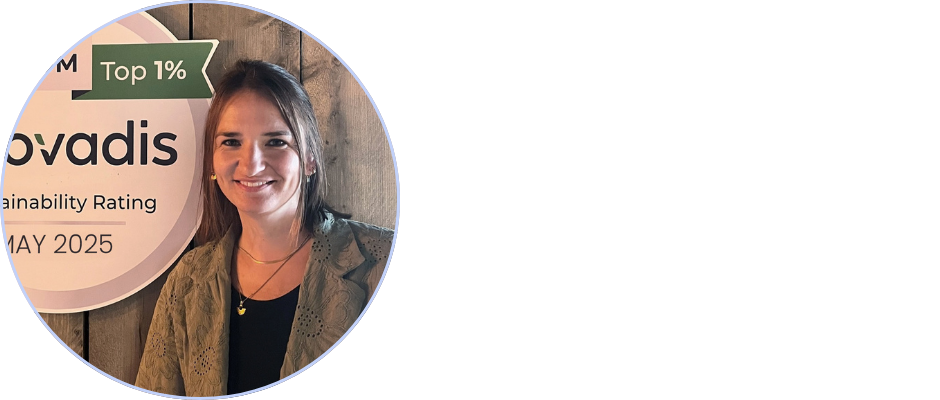Tackling textile’s toughest challenge
How Texet Workwear creates workwear that lasts
Interview with Kim Vandeneede, CSR & Sustainability Specialist at Texet Workwear
Interview with Kim Vandeneede, CSR & Sustainability Specialist at Texet Workwear

Making the textile industry more sustainable means rethinking everything—from the fabric to the factories, the packaging, and the people. For Kim Vandeneede, CSR & Sustainability Specialist at Texet Workwear, this transformation has been a full-time commitment for her for two and a half years and for Texet for 5 years.
Texet Workwear, part of the Swedish New Wave Group, supplies workwear all over Europe. But behind their durable clothing lies an equally strong sustainability strategy. We spoke with Kim to unpack how Texet manages the supply chain and stakeholder relationships in one of the most complex sectors—and what other ESG professionals can learn from her experience.
The textile industry faces unique sustainability challenges. From raw material sourcing to dyeing, stitching, finishing and packaging, the value chain is global, fragmented, and highly resource-intensive. Ensuring environmental and social standards at each stage requires coordination across continents, cultures, and compliance systems.
To manage this complexity, Texet relies on a structured approach. As part of the New Wave Group, they work with third-party organisations like Amfori BSCI and BEPI to audit their production partners. Before production begins, every factory must sign Texet’s code of conduct, restricted substance list, and supplier handbook.
In 2025, Texet is deepening its environmental oversight by focusing on tier 2 factories. These suppliers provide materials such as fabrics, dyes, or trims to the factories that assemble the garments.
But it’s not all about auditing and paperwork. “We also have local teams in Shanghai and Bangladesh who visit the factories,” Kim says. “That on-the-ground presence makes a real difference.”
Clients and partners increasingly ask for LCA data on textile products, such as carbon footprint, water use, and energy consumption. A call for tenders and communication efforts mainly drive them.
“But LCA results aren’t easy to compare,” Kim warns. “Some calculate cradle-to-port, others cradle-to-shelf. That’s why we always provide context, not just numbers.”
To be more and more transparent, Texet is also preparing for the EU’s Digital Product Passport, which will be mandatory by 2027. The goal is to have a QR code linked to each item, giving complete visibility into its supply chain.
Sustainability isn’t limited to the CSR department at Texet—it’s part of the culture. “We often say: sustainability is a standard here,” Kim shares.
Leadership support plays a key role. “Our CEO saw early on that we couldn’t ignore this. He said, ‘Let’s be ahead of it. Let’s ensure our clients don’t need to worry—we’ve already done the work for them.”
That mindset filters down. The company meets over lunch every quarter to hear business updates, including a few minutes on sustainability. Kim invites employees to share ideas, and they do.
“One time, three warehouse staff independently told me our shipping process used too much paper and plastic. It was something that we wouldn’t have been able to see without the contribution of the staff. Now we’ve changed it. We’ve even set up a small internal group with reps from HR, sales, and the warehouse.”
Texet’s structured approach to sustainability doesn’t end with internal audits—it’s validated externally through their EcoVadis certification. In 2025, they reached a significant milestone: for the third consecutive time, Texet achieved Platinum status. This year, they earned an impressive score of 91/100, placing them in the top 1% of companies in their sector.
EcoVadis evaluates companies across four pillars: environment, labour and human rights, ethics, and sustainable procurement. Kim sees it as a practical ESG roadmap: “The questions evolve yearly. They become stricter. That challenges us and helps keep our strategy dynamic.”
“Sustainability isn’t something you fix in a year,” Kim says. “Each time we receive an EcoVadis assessment, we look at what’s strong, what needs work, and we improve step by step.”
For new ESG professionals, she offers simple but powerful advice: “Think in terms of impact, not in image. Immerse yourself in the business. Stay curious. Ask the hard questions. The more you understand, the more you’ll see where real change is needed. The gaps will reveal themselves—and that’s where your impact begins.”
Her first months were challenging, but after two and a half years, she contributes to developing and implementing an ambitious, measurable strategy for Texet in one of the most complex industries.